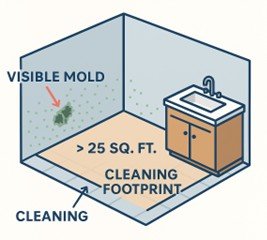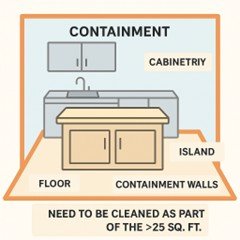Do You Need a Licensed Mold Contractor? Understanding the
25 Contiguous Square Feet Rule
When Texas homeowners or property managers discover mold, one of the first questions is: “Do I need to hire a licensed mold contractor?”
The Texas Department of Licensing and Regulation (TDLR) addressed this in their Mold Monitor (April 2025 edition) by revisiting the well-known “25 contiguous square feet” rule. This rule is often misunderstood, and the mistake usually comes down to focusing only on what you can see instead of what must actually be remediated.
The Rule in Plain English
Under Texas law, if mold contamination affects a total surface area of 25 contiguous square feet or more, the work must be done by a licensed Mold Remediation Contractor (MRC).
And here’s the critical detail: that surface area isn’t limited to visible mold. TDLR clarifies that the entire area requiring cleaning, removal, or treatment counts toward the total. Mold growth isn’t limited to what you can see. Spores are microscopic and can easily settle on nearby surfaces – cabinets, flooring, insulation, or even belongings inside the containment.
That’s why remediation activities always include cleaning, wiping, HEPA vacuuming, and treating surfaces beyond the visible mold.
That means if you need a licensed contractor, you also need a Mold Assessment Consultant (MAC) like NTX Enviro to develop the protocol that guides the remediation work.
How the 25 Square Feet Adds Up
Even projects that appear small often require licensed professionals once you factor in the cleaning footprint. For example:
- A small area of mold under a sink: Once you clean the entire vanity, cabinet interiors, wall surfaces, and flooring inside containment, the total quickly exceeds 25 sq. ft.
- Mold inside a kitchen sink cabinet: Cleaning could include cabinetry, the area behind the cabinetry, wall cavities, flooring, baseboard, any additional cabinetry inside containment, and often adjacent counters – much larger than the original area with visible mold.
- Mold around an HVAC return vent: Cleaning duct surfaces, drywall around vents, vent registers, the HVAC system, etc. often totals 25 sq. ft. or more.
- Preventive Measures: Surfaces treated with HEPA vacuuming, antimicrobial sprays, or sanitizing solutions all count toward the total.


Why It Matters
Once the 25 contiguous square foot threshold is met, you cannot legally proceed without:
- A licensed Mold Remediation Contractor (MRC) to perform the work.
- A licensed Mold Assessment Consultant (MAC) to provide the remediation protocol.
This two-part system ensures the project is done correctly, safely, and in compliance with TDLR’s mold regulations.
For property owners, this isn’t just red tape – it’s protection. A licensed team means trained workers, insurance coverage, written plans, and a clear process that reduces liability and ensures the mold problem is properly addressed.
Key points
- Residential exemption: The Texas Occupations Code §1958 (and TDLR’s administrative rules) specifically exempts residential property owners who perform mold remediation on their own property. That exemption applies no matter the size of the affected area.
- 25 contiguous square feet rule: The “25 contiguous square feet” threshold applies when someone other than the owner is hired to do the work. At that point, the law requires that a licensed Mold Remediation Contractor (MRC) be involved and a licensed Mold Assessment Consultant (MAC) is needed to write the protocol and perform clearance.
- Non-residential properties: The exemption does not apply in the same way. For commercial or rental properties, once the contaminated area meets or exceeds 25 contiguous square feet, licensed professionals must be used unless the work is done directly by the owner, tenant, or their employee/agent on their own property.
The key takeaway is:
👉 A Texas homeowner can legally remediate mold themselves, even above 25 sq. ft.
👉 But if they hire anyone else to do the work, and the affected area is ≥25 sq. ft., that work must be done under a licensed Mold Remediation Contractor and Mold Assessment Consultant.
| Who is doing the work? | Type of Property | Size of Mold Area | License Required? | Notes |
|---|---|---|---|---|
| Residential Property Owner (primary residence, fewer than 10 dwelling units) | Residential (1–9 dwelling units) | Any size (even ≥25 sq. ft.) | No | §1958.102(e) – Owner can remediate their own property without a license, regardless of square footage. |
| Tenant (remediating own leased space) | Residential/Commercial | <25 sq. ft. | No | Exempt under §1958.102(c). |
| Tenant | Residential/Commercial | ≥25 sq. ft. | Yes | Once 25 contiguous sq. ft. is reached, must use licensed MRC/MAC. |
| Owner, Managing Agent, or Employee (commercial property) | Non-residential property (commercial, rental w/ 10+ units, etc.) | <25 sq. ft. | No | Exempt under §1958.102(c). |
| Owner/Agent/Employee (commercial property) | Non-residential property (10+ units, etc.) | ≥25 sq. ft. | Yes | Must hire licensed MRC/MAC. |
| General Contractor (working on new build or improvement) | One- or two-family dwelling under construction/improvement | Any size | No (if done at same time as construction/improvement) | §1958.102(d). Exemption lost if they “engage in the business” of public mold work. |
| Anyone else (e.g., handyman, unlicensed contractor, friend, etc.) | Any | <25 sq. ft. | No | Allowed if under 25 contiguous sq. ft. |
| Anyone else | Any | ≥25 sq. ft. | Yes | Must hire licensed MRC/MAC. |
The Bottom Line
The TDLR April 2025 Mold Monitor reminds us that the 25 square feet rule isn’t just about visible mold growth. It’s about the total remediation area, including every surface that must be cleaned, removed, or treated.
If your project reaches that threshold, and most do once everything is added up, you’ll need both a licensed Mold Remediation Contractor and a licensed Mold Assessment Consultant like NTX Enviro.
👉 Contact NTX Enviro today if you suspect mold in your home or building. We’ll evaluate your situation, provide a compliant protocol, and guide you through the remediation process so you can be confident your project meets Texas law.
